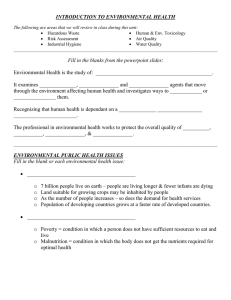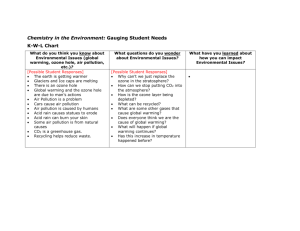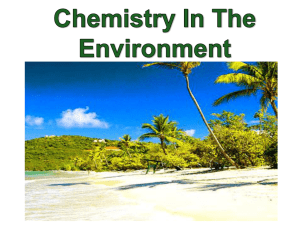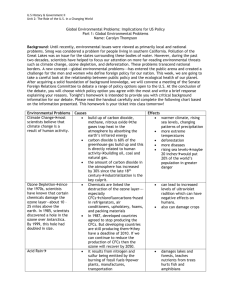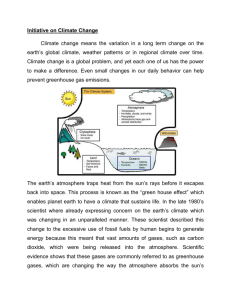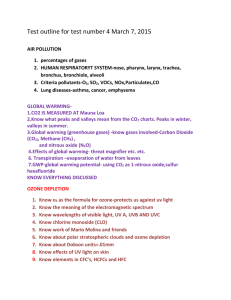ENV Ch 16 Air quality.doc
advertisement
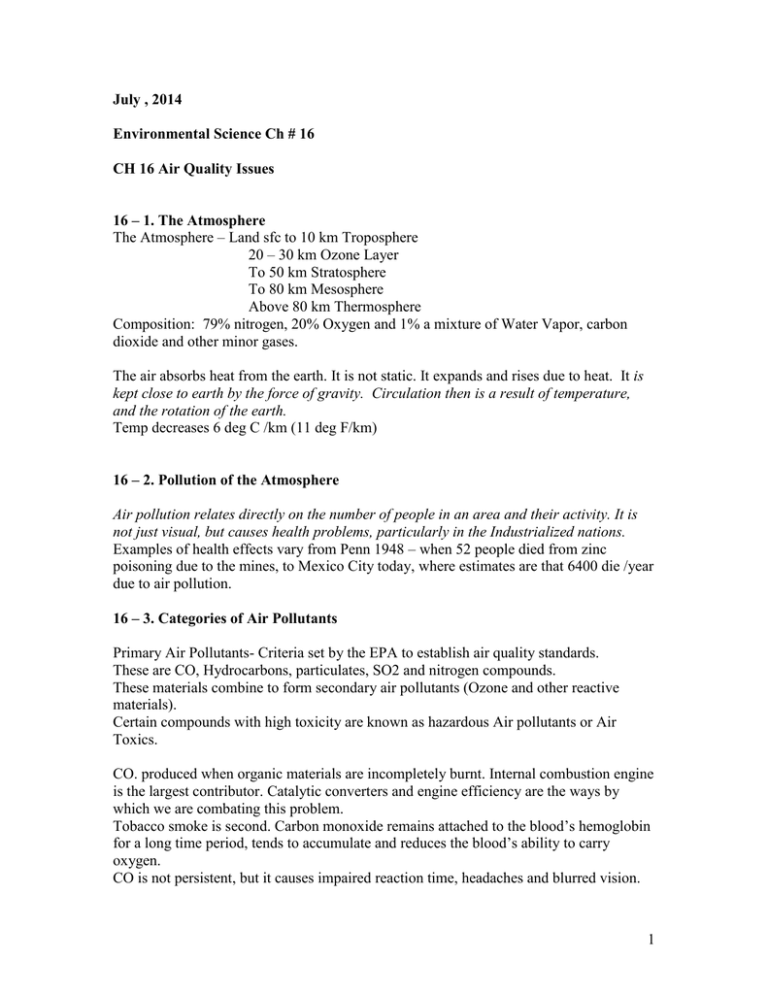
July , 2014 Environmental Science Ch # 16 CH 16 Air Quality Issues 16 – 1. The Atmosphere The Atmosphere – Land sfc to 10 km Troposphere 20 – 30 km Ozone Layer To 50 km Stratosphere To 80 km Mesosphere Above 80 km Thermosphere Composition: 79% nitrogen, 20% Oxygen and 1% a mixture of Water Vapor, carbon dioxide and other minor gases. The air absorbs heat from the earth. It is not static. It expands and rises due to heat. It is kept close to earth by the force of gravity. Circulation then is a result of temperature, and the rotation of the earth. Temp decreases 6 deg C /km (11 deg F/km) 16 – 2. Pollution of the Atmosphere Air pollution relates directly on the number of people in an area and their activity. It is not just visual, but causes health problems, particularly in the Industrialized nations. Examples of health effects vary from Penn 1948 – when 52 people died from zinc poisoning due to the mines, to Mexico City today, where estimates are that 6400 die /year due to air pollution. 16 – 3. Categories of Air Pollutants Primary Air Pollutants- Criteria set by the EPA to establish air quality standards. These are CO, Hydrocarbons, particulates, SO2 and nitrogen compounds. These materials combine to form secondary air pollutants (Ozone and other reactive materials). Certain compounds with high toxicity are known as hazardous Air pollutants or Air Toxics. CO. produced when organic materials are incompletely burnt. Internal combustion engine is the largest contributor. Catalytic converters and engine efficiency are the ways by which we are combating this problem. Tobacco smoke is second. Carbon monoxide remains attached to the blood’s hemoglobin for a long time period, tends to accumulate and reduces the blood’s ability to carry oxygen. CO is not persistent, but it causes impaired reaction time, headaches and blurred vision. 1 CO2 in 1958 was 315 ppm, and in 2012, it was 393 ppm. 20% increase. About 60% of the CO2 results from automobiles driven on the roadways and 25% from off road activities. Volatile Organic Compounds VOCs - Hydrocarbons. Automobiles emit most of it. To lower this content, several modifications have been made in the auto. (Valves, recycling through the engine, catalytic converters). Otherwise, VOCs are washed from the atmosphere by rain. Particulates. (10 microns and smaller). Cause problems ranging from soot settling to carcinogens in the air. Particulates attract other potentially dangerous materials such as sulfur, nitric and carbonic acids, which irritate the lining of our respiratory systems when inhaled. Sulfur Dioxide – SO2. is Produced when sulfur- containing fuels are burnt. It has a sharp odor and is irritating. Reacts with water and oxygen to form acid. Coal burning in London has been banned since 1306 by Edward 1. SO2 is a major source of acid rain and smog. London 1952—Smoke & Soot + Fog = smog accounted for 4000 deaths Penn. 1948 – Particles and Sulfur Dioxide = 52 deaths. Nitrogen Oxides - NOx. When combustion occurs in open air, nitrogen and oxygen may react with each other to form Nitrogen Monoxide (NO) and Nitrogen Dioxide (NO2.. Autos are the primary source of nitrogen oxides when subjected to high temperatures. Lead - Pb. Enters the body through breathing and consumption. It accumulates to cause mental retardation and Kidney damage. Its main sources are Gasoline and paint. Since being banned in the US the lead in atmosphere has dropped 98%. 50% in the rest of the world. Human Activity and the Patterns of Smog Development Ground level Ozone and Petrochemical Smog Smog is a mixture of primary pollutants, resulting from the interaction of nitrogen oxides with UV light. Ozone and Peroxy-acetyl nitrates are the main components of smog. Ozone is particularly dangerous because it destroys chlorophyll and injures lung tissue. Pxn is an oxidizing agent and as such, reacts with most other substances as well as irritates the eyes. A typical series of events: Morning rush hour produces nitrogen oxides (NO + NO2) Nitrogen oxides react with oxygen to form nitrogen dioxide, reddish brown color in the smog. Later in am, nitrogen dioxide reacts with UV light to form atomic Oxygen & NO. Atomic oxygen reacts with molecular oxygen to form ozone. Ozone reacts with HC to produce peroxy-acetyl nitrate. 2 Some cities are prone to problems due to climate, traffic and geographic features. One effect of temperature is Thermal Inversion. When cool air replaces the warm air upwards, which in turn is trapped between two cool layers of air. Other Hazardous Significant Air Pollutants Recognized as affecting health during last decade: radon, lead and toxic chemicals. Gasoline was the major source of lead, now it is for benzene. Paints in older buildings, and Batteries Toxic chemicals are released by factories, where pesticides are manufactured and Dry Cleaners operate. 16 – 4. Control of Air Pollution (Actions that have reduced Air Pollution) Clean Air Act Inspite of a population increase of 31%, air pollution has been cut by 30%, Acid rain decreased by 25% (1970 – 2000). States are responsible. Benefits include health, decrease in erosion of artifacts Other changes and modifications made include: Motor vehicle emissions Introduction of PCV and APC valves to control HC vapors. Addition of Catalytic converters Introduction of lead free gasoline Control of Particulate matter A variety of sources exist. Factories, the internal combustion engine and land Use Processes that produce dust. Smoke stacks. Filters, Scrubbers and Precipitators in smoke stacks Elimination of wood burning stoves to reduce the “brown cloud” problem Ban high sulfur fuel usage (lignite) Treat sulfur bearing coals Use of Nuclear power plants. Control of Power Plant Emissions Methods to control SO2 are: * Switch to low sulfur fuel. * Remove sulfur from fuel before burning. * Scrubbing gases before emission. 3 16 – 5. Acid Deposition Causes: Acid forming reactants are classified as Wet or Dry. Acid rain is a worldwide problem. Normally rain has a pH between 5.6 and 6.7 due to atmospheric carbon dioxide. Acid rain has been measured at 2.1. It damages buildings, monuments and metal surfaces. Effects on Terrestrial Ecosystems: The effects on the ecosystem are more difficult to quantify. The death of a forest is the most noticeable in Europe. When the soil becomes acidic, Aluminum is released and it prevents the roots from absorbing nutrients. It also changes the type of bacteria resident in the soil Effects on Aquatic Ecosystems: Acid rain also affects aquatic systems. There is a progressive loss in biodiversity as the water body becomes more acidic. Shallow water is the first and most affected. Neutralization occurs where the bedrock is limestone. Acid shock occurs at springtime. 16 – 6. Ozone Depletion Three Oxygen atoms – Ozone shields earth from UV radiation. Chlorine reacts with and destroys ozone, by removing an oxygen atom from the Ozone in the Layer (12 – 25 Km) above earth’s surface. Ozone absorbs 99% of UV light and is broken down into O2 and atomic Oxygen . UV B rays causes skin cancer and cataracts, and increases cell mutations in living things. In 1985 significant thinning was discovered over Antarctica. Depletion was caused by CFCs. Chlorine combines with Ozone to produce Oxygen and ClO; ClO combines with atomic O to form Cl and O2. The Montreal Protocol banned CFCs manufacture. Why is Stratospheric Ozone Depletion important? 16 – 7. Global Warming and Climate Change Atmospheric CO2, and Methane have increased significantly over the last years since the industrial revolution. Computer simulations of climate indicate a rise in global temperatures (warming) with an increase concentration of CO2. Scientists conclude that: 4 Temperature of earth increased 0.3 – 0.6 Degree C and sea level rose 4 –10 “ in the last 100 years.There is a strong tie between amount of green house gases in the atmosphere and Temperature increase over 160,000 years Human activity increases the amount of greenhouse gases. There is a need to recognize that global warming will not affect the world equally. Some regions would be affected by both magnitude of change and rate of change. Not all areas are sensitive to climate changes Poorer nations may be affected most. Where farming is subsistence scale and there is a lack of resources, damage will be significant. Areas of concern include Human health Rising MSL Disruption of the Hydrologic cycle Changing forest biome Food supply Causes of Global Warming and Climate Change Global warming is being caused by several gases in the atmosphere, which are transparent to light but absorb infrared radiation. (Gases allow sunlight to penetrate the atmosphere and be absorbed by the earth). The energy is reradiated from the earth as infrared radiation (heat). This heat is absorbed by these gases (greenhouse gases) and the warming is the greenhouse effect. Potential Consequences of Global Warming Worsening Health Effects. To be expected are increased mortality from heat related stress. Increasing temperature will exacerbate air quality problems (smog). Extreme temperatures can lead to death. It also increases the ozone concentration at ground level. Vector borne diseases Rising MSL Expected rise in sea level will cause beach erosion. The oceans will continue to rise after the CO2 level is stabilized in the atmosphere. Disruption of the water cycle Droughts/floods and water quality and quantity are the most serious concerns. Evaporation and precipitation will change, leading to water levels dropping in lakes and rivers. 5 Navigation and power generation will be disrupted. Water supply and demand will be impacted as will Environmental quality (pollution variations) and recreation Flood control could be a major problem. There will be Political issues in countries which depend for outside water supplies. Changing Forest and Natural areas Climatic zone changes will dramatically alter distribution of vegetation. This condition in turn will have an economic impact of major proportion. Changes in weather patterns Challenges to Agriculture and Food Supply Climate changes will affect food crops. Locally, yields will change. So will the pest populations. The most important GHG gases are: CO2 – most abundant. Normally it is the result of respiration, but significant quantities are added from burning fossil fuel and wood to produce heat and electricity. Increased from 315 ppm to 393 ppm (1958 –2012). To slow down, it would be necessary to increase fuel efficiency (carbon tax), plant trees (short term), stop forest destruction. CFCs – retains >15,000 X more heat than CO2. This gas has also been linked to the Ozone layer depletion. The Montreal Protocol addresses this problem. Methane – enters the atmosphere from biological sources. No control. Nitrous Oxide – minor, from fossil fuels and fertilizers. 16 – 8. Addressing Climate Change Energy Efficiency 1st. step to slow global warming is to increase energy utilization efficiency. 2nd. Step is to decrease the carbon dioxide in the atmosphere (plant trees) 3rd. step is to decrease the destruction of natural forests. The incentives for change are reinforced by globalization of the economy. Globalization forces manufacturers to produce for a wider client target. Reduction of greenhouse gases will benefit health, and indirectly production (less sick days). Alternative fuels can lead to rapid improvements. The Role of Biomass Forests can tie up carbon for centuries. They are very efficient in capturing CO2. Planting trees has also supported as a way to reduce CO2 in the atmosphere. Technological Approach 6 The use of wind, solar, hydroelectric power, etc. has been proven as ways to reduce CO2 in the atmosphere.. It is also possible to capture and store underground . International Agreements Agreements have been reached that lead to reduction of CFCs being released. The Kyoto Protocol (1997) was a first step to alleviating the greenhouse gases emissions. 16 – 9. Indoor Air Pollution Can lead to serious health problems. >350,000 people die every year as a result of indoor pollution. Sources o Indoor Air Pollution Pollutants include asbestos, particulates and smoke from cigarettes. Winterizing buildings cause slower air circulation. Every 5 hrs. 16 – 10. Noise Pollution Measured in decibels (db). Causes hearing loss and can kill at 180 dbA. 7
